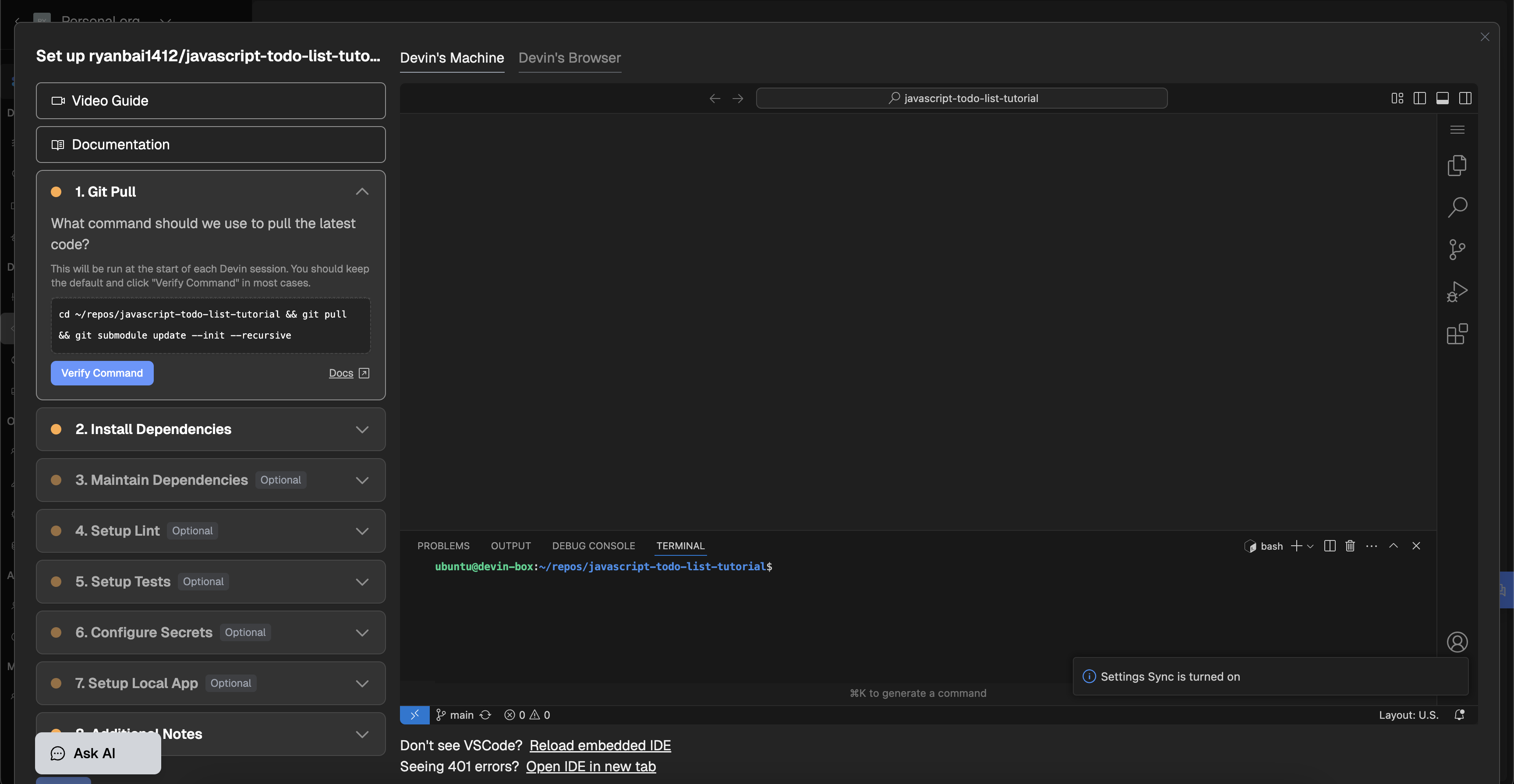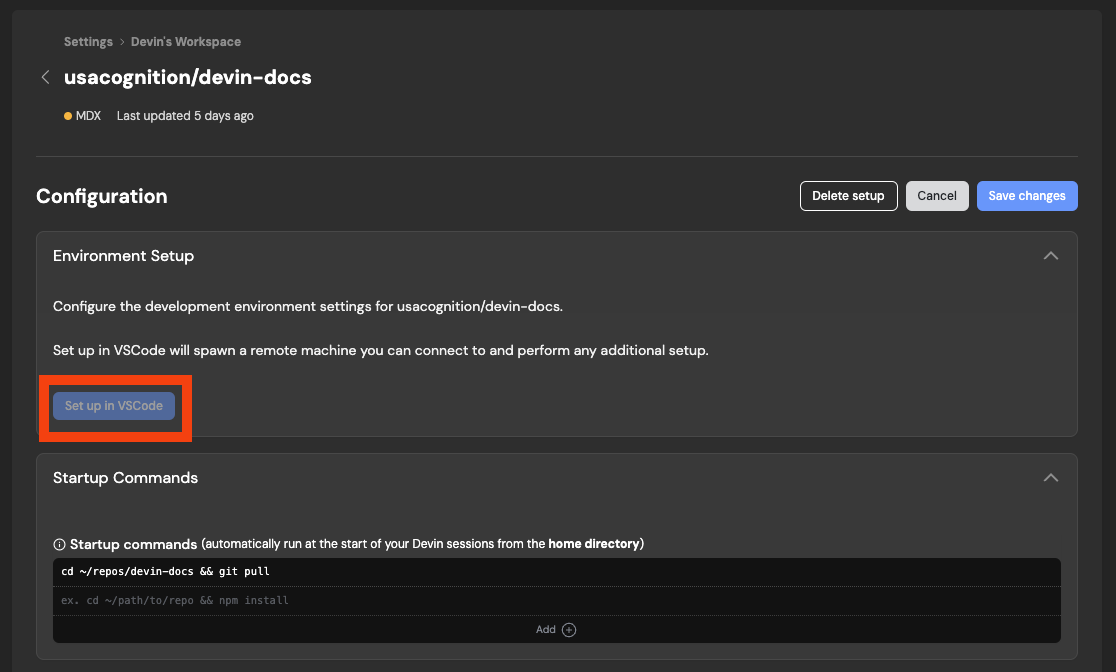Set up a repository
First, make sure Devin has access to your repositories. Repositories can be added at any point by going to Settings > Integrations and configuring Devin’s access.Refer to the GitHub Integration Guide for more information

~/repos. Do not move or delete those directories. The repository you’re currently setting up has already been cloned, and the machine also contains any other repositories you’ve set up in the past.
After you finish the repository set up, a snapshot of the virtual machine will be saved. Future Devin sessions will start from this snapshot and will include any tools or dependencies you’ve installed during the setup process.
Follow the below steps and the instructions on screen to set up the repository. You can always come back and edit the repository setup after saving. You can also follow along our video guide below.
1
Git Pull
Enter the command Devin should run at the start of each session to pull the latest changes from the repository. In most cases, you should keep the default command. Make sure that Devin has access to the submodules in the repository.
2
Configure Secrets
Set up any secrets Devin will need. When possible, we recommend directly adding a
.env file to Devin’s workspace. This example shows how to do this with direnv.Other secrets, such as passwords, can be added in the secrets dashboard.3
Install Dependencies
Use VS Code to set up all the tools and dependencies Devin will need to work on the repository. After this step, Devin should be able to run all the commands he needs (e.g. lint, test, build, etc.) without any additional installation steps. Devin’s machine is running on Ubuntu 22.04 (x86_64).Suggestions:
- Install compilers, interpreters, build tools, package managers, linters, formatters, test runners, etc.
- Install package dependencies (e.g.
npm install,pip install -r requirements.txt, etc.)
4
Maintain Dependencies
Enter the command Devin should run at the start of each session to keep dependencies up to date. This likely should be the same command as the one you used to manually install dependencies (e.g.
npm install, pip install -r requirements.txt, etc.).The purpose of this is to ensure that Devin can update his local dependencies if they get added to the git repository.5
Setup Lint
Enter commands that Devin should run to lint the repository. Devin will look at the output of these commands before he commits changes.These commands should terminate in 5 minutes or less so Devin doesn’t have to wait too long for them. Click verify to check that the commands are working.Tips:
- If necessary, you can first run the commands in the VS Code terminal to induce caching.
- If the command needs to run in a specific directory, you can use
cdlike so:cd <directory> && <lint command>. - If your project doesn’t have a lint command, you can include your build command so Devin checks for compilation errors.
- You can also include a command here that checks for code formatting style.
- If the lint procedure for your process is complex, you can skip this step and explain linting to Devin in the Additional Notes step below.
Check out the troubleshooting section if you encounter issues with verifying your commands.
6
Setup Tests
Enter commands that Devin should run to test the repository. Like with the lint commands, Devin will look at the output of these commands before he commits changes. These commands also have a 5 minute time limit. Click verify to check that the commands are working.Tips:
- If necessary, you can first run the commands in the VS Code terminal to induce caching.
- If the command needs to run in a specific directory, you can use
cdlike so:cd <directory> && <test command>. - If the test procedure for your process is complex, you can skip this step and explain testing to Devin in the Additional Notes step below.
Check out the troubleshooting section if you encounter issues with verifying your commands.
7
Setup Local App
Let Devin know how to run your code locally. This is useful if Devin needs to run your code to test or debug changes.
8
Additional Notes
Add any additional notes that you think are important for Devin to know when working on this repository.
Examples
Below are some examples of how to set up Devin’s workspace for different use cases. Since Devin runs all commands using bash, one common pattern is to edit the~/.bashrc file to automatically set up Devin’s shell. You can run devin ~/.bashrc in the terminal to edit the file in VS Code.
Configuring Environments Automatically for Different Repositories
Say you have two repositories that require different versions of Node, and you want Devin to automatically use the right version for each repository. We’ll usenvm to install and manage the Node versions. nvm should already be installed in Devin’s machine.
First, we’ll install the two versions of Node by running the following commands in the VS Code terminal:
~/.bashrc by running devin ~/.bashrc in the terminal. Append the following to ~/.bashrc.
nvm use 18 whenever Devin is in the node18 repo and nvm use 20 whenever Devin is in the node20 repo.
Configuring Environment Variables
We’ll go over how to usedirenv to manage environment variables. First, we’ll follow direnv’s installation instructions to install it on Devin’s machine. After April 24 2025, direnv should automatically be installed on new teams’ machines.
We’ll first install direnv by running the following command in the VS Code terminal:
~/.bashrc to set up the direnv hook. You can open up ~/.bashrc by running devin ~/.bashrc in the terminal.
.envrc file in the root of our repository that might look something like this.
direnv allow in the terminal to load the environment variables.
Devin will now have the environment variables in our .envrc file added to his environment when working in our repository in future sessions.
Adding Directories to the System PATH
We can edit~/.bashrc to add directories to the system PATH. This will make it easier for Devin to run the executables in those directories. For example, we can append the following to ~/.bashrc which will add the ~/bin directory to the system PATH.
~/bin directory without having to specify the full path.
Logging In to Websites
During repository setup, you can use the Browser tab to log in to any website that you want Devin to interact with. These session cookies will be stored in Devin’s workspace and will be available to Devin in future sessions. If you are using a website that times out your login frequently, you will also want to set Devin up with credentials in your Secrets dashboard.Troubleshooting
What do I do if I accidentally break something during repo setup?
If during repo setup you accidentally introduce a breaking change, you can always revert to a previous machine image. Go to Settings > Devin’s Workspace and click on Version History to see a list of previous machine images. You can then click on the machine image you know worked correctly and click Restore version.Why aren’t my commands being verified?
If you run into an error when verifying one of the commands, try to inspect its output in the VS Code terminal and also try to run the command yourself in a fresh terminal.- Check the path of the executable you are running. We strongly recommend either using absolute paths or adding executables to the system PATH.
- Make sure you’ve installed the necessary tools and dependencies to run the command. If you haven’t, use the terminal to install them and verify again.
- Check that the commands are being run in the right directory. If the commands need to run in a specific directory, you can use
cdlike so:cd <directory> && <command>. - Check that you are using the right language versions (e.g. right versions of Node, Python, etc.).
- You might want to modify your
~/.bashrcto automatically use the right environment. Check out our guide for an example of how to use the right language version for different repositories.
My commands work when I run them manually
Check that you’ve setup your bashrc so that a fresh bash shell has access to the necessary tools. Try running your commands in a fresh terminal. If they don’t work, you will likely need to edit your bashrc, for example by running certain setup commands or editing the system PATH. Check out our guide for an example of how to use the right language version for different repositories. Commands will timeout after 5 minutes. You can induce caching by running the commands in the VS Code terminal before verifying. We do not recommend giving Devin commands that take longer than 5 minutes to run, as it will significantly slow it down.Homebrew is asking me for a password
This is a bug in Linux Homebrew. RunCI=1 brew install <package> instead.
Devin can’t run my lint/test commands in sessions
Take a look at the output of Devin’s terminal to see if you can spot any errors. You can also try running the commands yourself in a fresh terminal to see if they work. If needed, you can revisit the repository setup process to make changes to Devin’s workspace.The git pull step isn’t working
Double check that Devin has access to the repository and submodules of the repository. Also check out the GitHub Integration Documentation if you run into any permission issues.Need to edit?
You can always edit or add a new repo in Settings > Devin’s Workspace. To edit an existing repo, click on it in Devin’s Workspace > click “edit” > click “Set up in VSCode”.
All Done!
Congrats! You’ve onboarded Devin and can start building together. It’s time to start your first session. Keep in mind that Devin works best when you:- Tell Devin how to check its progress
- Break down big tasks
- Share detailed requirements upfront
- Run multiple sessions in parallel
